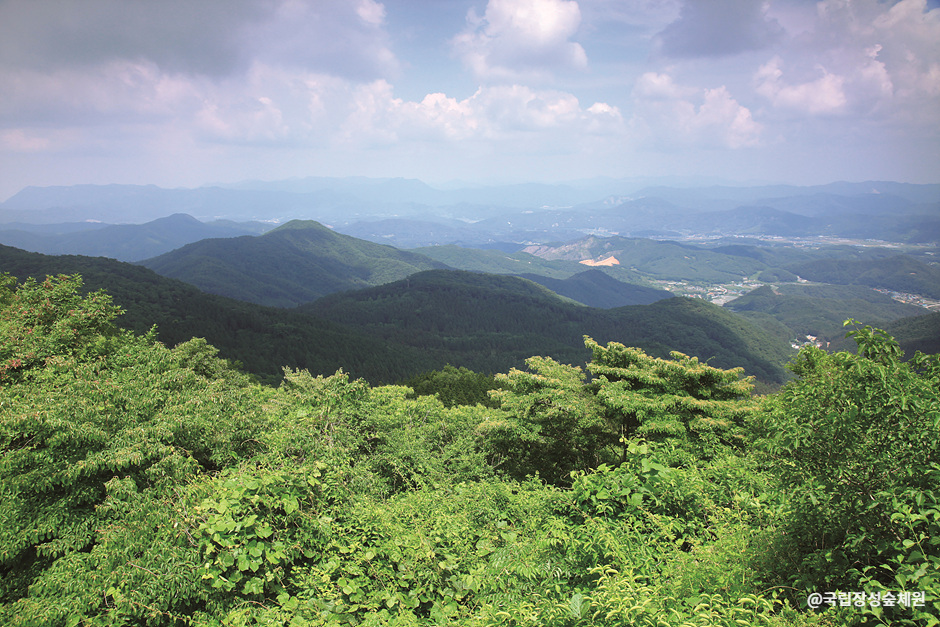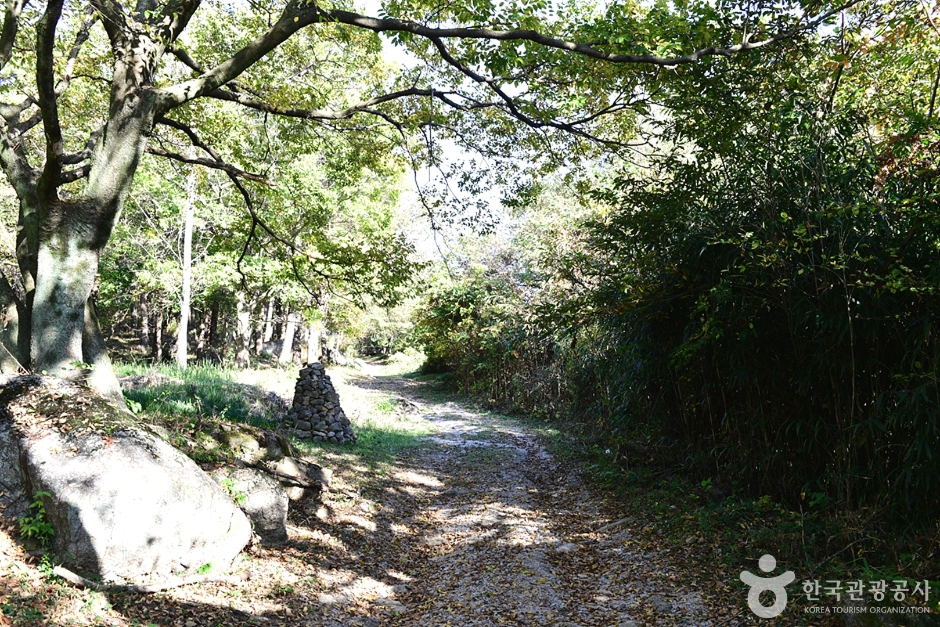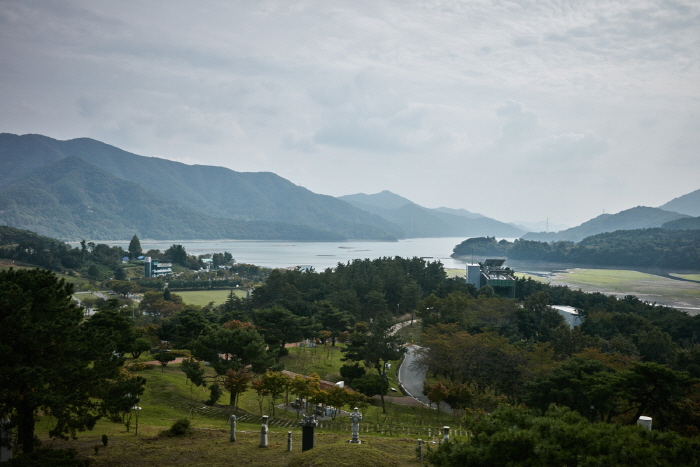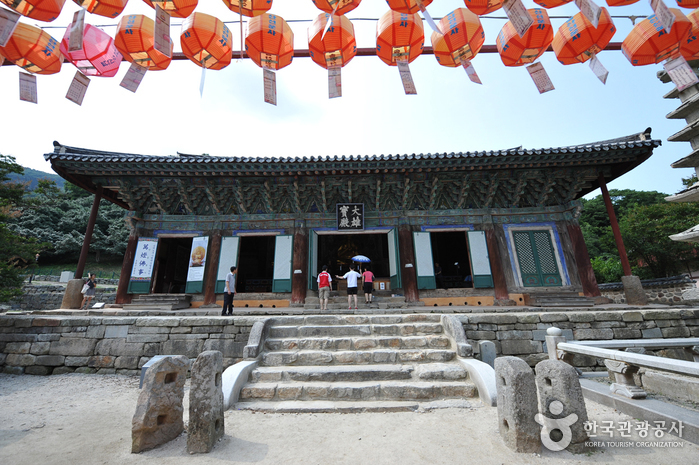Gochang Munsusa Temple (문수사 (고창))
5.9 Km 30903 2024-04-07
135, Chilseong-gil, Gochang-gun, Jeonbuk-do
+82-63-562-0502
Nestled on the slope of Munsusan Mountain (alt. 621 m) in Gochang, Jeollabuk-do and Jangseong, Jeollanam-do, Munsusa Temple is located in the area of a dense mountain ridge to the west of Gosu Kiln Site in Gosu-myeon, and Josan Reservoir. The ridge features clean water and a thick forest that has remained uncontaminated due to its isolated location.
The temple's establishment date is uncertain. The temple houses Daeungjeon Hall (Local Tangible Cultural Heritage No. 51) and Munsujeon Hall (Local Tangible Heritage No. 52), as well as Myeongbujeon and Hansanjeon Halls. Daeungjeon is a small building featuring the unique architecture of gable roofing. Visitors will be fascinated by the temple's scenery, boasting valley waters flowing from dense forests. It is particularly beautiful in fall, when the autumn foliage harmonizes well with the colors of the old temple. The temple grounds are surrounded by a colony of maple trees 100 to 400 years old.
The Forest of Maple Trees at Munsusa Temple, Gochang, was designated in 2005 as Natural Monument No. 463. It covers the area from the entrance of Munsusan Mountain to the entrance of Munsusa Temple with nearly 500 maple trees lining the 80 meter-long path.
Ungok Ramsar Wetland (고창 운곡람사르습지)
6.1 Km 0 2024-04-07
362 , Ungokseowon-gil, Gochang-gun, Jeonbuk-do
+82-63-560-2720
Ungok Ramsar Wetland, registered as Ramsar Wetland in 2011, is home to endanged species and various rare animals and flowers. The wetland also has four different courses that will take visitors all around the wetlands. Course 1 takes approximately 50 min and is 3.6 km-long. Course 2 takes approximately 2 hour 30 minutes and is 9.5 km-long. Course 3, the longest out of the 4 courses takes approximately 3 hours 30 minutes and is 10.2 km-long. Last, Course 4 takes approximately 2 hours 50 minutes and is 10.1 km-long.
National Jangseong Healing Forest (국립장성치유의숲)
7.4 Km 53865 2024-02-20
716 Chuam-ro, Seosam-myeon, Jangseong-gun, Jeollanam-do
National Jangseong Healing Forestis a natural recreational facility located in the Chungnyeongsan National Forest, opened in 2011. Visitors can be relaxed by walking along the cypress forest trail emitting phytoncides. There are seven hiking courses designed with various themes and slopes. Following the main course, the "Well-being Forest Path," hikers will encounter the Chungnyeongsan Observatory, where they can enjoy panoramic views of the mountain and see the cypress forest at a glance.
Namchanggyegok Valley (남창계곡)
12.5 Km 17960 2021-07-27
Namchang-ro, Jangseong-gun, Jeollanam-do
+82-63-538-7875
Namchanggol Valley, located at the foot of Ibamsan Mountain with a x_height of about 654 meters, belongs to the southern part of Naejangsan National Park (Namchang District). It consists of six valleys, including Sanseong, Eunseon-dong, and Banseok-dong (Saejaegyegok Valley). Nearby there is the Chonnam National University training center and beautiful surrounding scenery. Despite being well-known, visitors can enjoy their time without being crowded making it a very good summer resort. Hermitages such as the famous Baegyangsa Temple, Yaksaam Rock, and Yeongcheongul Cave, Jangseongho Lake and Bija grove are nearby as well. In particular, Ibamsanseong Fortress located in the upper reaches of the valley is Pogoksiksanseong Fortress built during the Samhan Period and designated as National Historic Site No. 384.
The Namchang Valley Nature Observation Trail, which is about 730 meters long, is equipped with various information boards and experience facilities related to nature learning, making it a good place for ecological learning. The nature observation path has themes to provide visitors with a variety of attractions, and the long stretch of cedar forest is also a must-see. In autumn, the maple leaves from the maple trees fall into the valley water creating a stunning scenery.
Gosan Mountain (고산)
12.6 Km 16316 2024-04-07
Sanggeum-ri, Daesan-myeon, Gochang-gun, Jeonbuk-do
Gosan Mountain is a beautiful mountain that rises sharply from the plains, offering stunning views from its summit at an elevation of 572 meters. The mountain delights hikers with lush pine forests and interesting rock formations. Gosan Mountain is also known for its numerous dolmens, dating back to prehistoric times, and the Gosansanseong Fortress, built during the Later Three Kingdoms period, providing plenty of attractions for visitors.
Seonunsan Mountain [National Geopark] (선운산 (전북 서해안 국가지질공원))
13.1 Km 27097 2024-04-07
158-6, Seonunsa-ro, Gochang-gun, Jeonbuk-do
+82-63-560-2699
Seonunsan Mountain is famous for its sunrise views at Nakjodae Overlook and Cheonmabong Peak. The mountain is mostly comprised of hard volcanic rocks, creating a landscape of sharp cliffs softened by the forest vegetation.
Jangseongho Tourist Area (장성호관광지)
13.2 Km 7107 2021-03-24
591-8, Baegyang-ro, Jangseong-gun, Jeollanam-do
+82-61-392-7248
Jangseongho Tourist Area is located south of Naejangsan National Park, in Jangseong, known as the hometown of Hong Gil-dong, a Korean Robin Hood. The lake was made by the damming of Hwangnyonggang River, and holds up to 89.7 million tons of water, filled with many freshwater fish species. In addition, the walking path along the 603-meter-long embankment attracts many tourists with beautiful views of the mountains and lake. Cruise ferries and motorboats also cross the lake. Nearby attractions include Ibamsan and Baegamsan Mountains, Namchanggyegok Valley, Baegyangsa and Naejangsa Temples, Gosanseowon Confucian Academy, Bangjangsan Recreational Forest, and more.
Gohyang Sikdang (고향식당)
13.3 Km 14999 2024-04-18
20-3 Jungchon-gil, Asan-myeon, Gochang-gun, Jeonbuk-do
Gohyang Sikdang is a highly recommended restaurant in Gochang known for its grilled eel dishes. Their signature dish is the Pungcheon jangeo yangnyeom gui (Pungcheon grilled marinated eel) seasoned with a sauce made from over 30 kinds of fruits and medicinal herbs, grilled to perfection. Pungcheon eel from Seonunsan is famous for its rich and savory flavor. They also offer other menu items such as jangeo tang (spicy eel stew) and dolsot sanchae bibimbap (hot stone pot wild vegetable bibimbap).
Dosolgyegok Valley (Seonunsan Mountain) (도솔계곡 (선운산))
13.3 Km 8803 2024-04-07
250, Seonunsa-ro, Gochang-gun, Jeonbuk-do
+82-63-560-8681
Dosolgyegok Valley is located in Seonunsan Mountain in the Gochang-gun district. Seonunsan Mountain, which is also called Dosolsan Mountain, is known for its thick forests and intriguing rock formations. Along the valley, there are many interesting sites such as Jinheungdonggul Cave, Yongmundonggul Cave, Nakjodae Overlook, and Cheonma peak. Dosolgyegok Valley is also famous for being very deep, where the mountain and water fight each other and whirl around in a yin & yang shape. The green forests in summer cover the valley beautifully, and the red leaves and white snow decorate the area in fall and winter.
Gochang Seonunsa Temple (선운사 (고창))
13.3 Km 37410 2024-04-07
250, Seonunsa-ro, Gochang-gun, Jeonbuk-do
+82-63-561-1422
Seonunsa Temple is known to have been built in 577, the 24th year of King Wideok of the Baekje dynasty. It is the second head temple of Jogye Order in Jeollabuk-do. According to the temple's historical records, it was originally a very large temple with 89 hermitages and 3,000 monks. Today, only four hermitages remain: Dosoram, Chamdangam, Dongunam, and Seoksangam. In addition, the temple is home to 25 prestigious heritages, namely the Forest of Common Camellias, which is designated as ㅁ Natural Monument. A festival dedicated to this forest is held every April.



![Seonunsan Mountain [National Geopark] (선운산 (전북 서해안 국가지질공원))](http://tong.visitkorea.or.kr/cms/resource/64/2678864_image2_1.jpg)


 English
English
 한국어
한국어 日本語
日本語 中文(简体)
中文(简体) Deutsch
Deutsch Français
Français Español
Español Русский
Русский